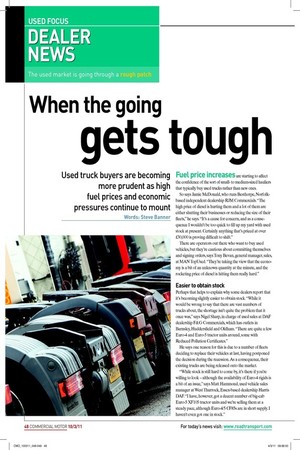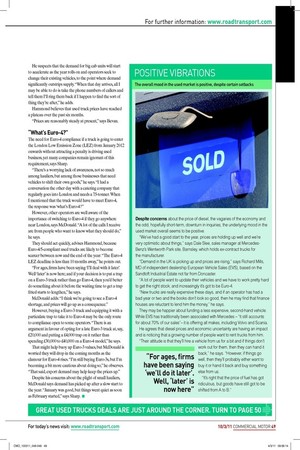When the going
Page 43

Page 44

If you've noticed an error in this article please click here to report it so we can fix it.
ets tou
Used truck buyers are becoming more prudent as high fuel prices and economic pressures continue to mount
Words: Steve Banner Fuel price increases are starting to affect the conidence of the sort of smallto medium-sized hauliers that typically buy used trucks rather than new ones.
So says Jamie McDonald, who runs Besthorpe, Norfolkbased independent dealership RJM Commercials. “The high price of diesel is hurting them and a lot of them are either shutting their businesses or reducing the size of their leets,” he says. “It’s a cause for concern, and as a consequence I wouldn’t be too quick to ill up my yard with used stock at present. Certainly anything that’s priced at over £30,000 is proving dificult to shift.” There are operators out there who want to buy used vehicles, but they’re cautious about committing themselves and signing orders, says Tony Bevan, general manager, sales, at MAN TopUsed. “They’re taking the view that the economy is a bit of an unknown quantity at the minute, and the rocketing price of diesel is hitting them really hard.”
Easier to obtain stock
Perhaps that helps to explain why some dealers report that it’s becoming slightly easier to obtain stock. “While it would be wrong to say that there are vast numbers of trucks about, the shortage isn’t quite the problem that it once was,” says Nigel Sharp, in charge of used sales at DAF dealership F&G Commercials, which has outlets in Barnsley, Huddersield and Oldham. “There are quite a few Euro-4 and Euro-5 tractor units around, some with Reduced Pollution Certiicates.” He says one reason for this is due to a number of leets deciding to replace their vehicles at last, having postponed the decision during the recession. As a consequence, their existing trucks are being released onto the market.
“While stock is still hard to come by, it’s there if you’re willing to look – although the availability of Euro-4 rigids is a bit of an issue,” says Matt Hammond, used vehicle sales manager at West Thurrock, Essex-based dealership Harris DAF. “I have, however, got a decent number of big-cab Euro-5 XF105 tractor units and we’re selling them at a steady pace, although Euro-4/5 CF85s are in short supply. I haven’t even got one in stock.” He suspects that the demand for big cab units will start to accelerate as the year rolls on and operators seek to change their existing vehicles, to the point where demand signiicantly outstrips supply. “When that day arrives, all I may be able to do is take the phone numbers of callers and tell them I’ll ring them back if I happen to ind the sort of thing they’re after,” he adds.
Hammond believes that used truck prices have reached a plateau over the past six months.
“Prices are reasonably steady at present,” says Bevan.
“What’s Euro-4?”
The need for Euro-4 compliance if a truck is going to enter the London Low Emission Zone (LEZ) from January 2012 onwards without attracting a penalty is driving used business, yet many companies remain ignorant of this requirement, says Sharp.
“There’s a worrying lack of awareness, not so much among hauliers, but among those businesses that need vehicles to shift their own goods,” he says. “I had a conversation the other day with a catering company that regularly goes into London and needs a 7.5-tonner. When I mentioned that the truck would have to meet Euro-4, the response was ‘what’s Euro-4?” However, other operators are well aware of the importance of switching to Euro-4 if they go anywhere near London, says McDonald. “A lot of the calls I receive are from people who want to know what they should do,” he says.
They should act quickly, advises Hammond, because Euro-4/5-compliant used trucks are likely to become scarcer between now and the end of the year. “The Euro-4 LEZ deadline is less than 10 months away,” he points out.
“For ages, irms have been saying ‘I’ll deal with it later’. Well ‘later’ is now here; and if your decision is to put a trap on a Euro-3 truck rather than go Euro-4, then you’d better do something about it before the waiting time to get a trap itted starts to lengthen,” he says.
McDonald adds: “I think we’re going to see a Euro-4 shortage, and prices will go up as a consequence.” However, buying a Euro-3 truck and equipping it with a particulate trap to take it to Euro-4 may be the only route to compliance open to some operators. “There is an argument in favour of opting for a late Euro-3 truck at, say, £20,000 and putting a £4,000 trap on it rather than spending £30,000 to £40,000 on a Euro-4 model,” he says.
That might help buoy up Euro-3 values, but McDonald is worried they will drop in the coming months as the clamour for Euro-4 rises. “I’m still buying Euro-3s, but I’m becoming a bit more cautious about doing so,” he observes. “That said, export demand may help keep the prices up.”
Despite his concerns about the plight of small hauliers, McDonald says demand has picked up after a slow start to the year. “January was good, but things went quiet as soon as February started,” says Sharp. ■














































